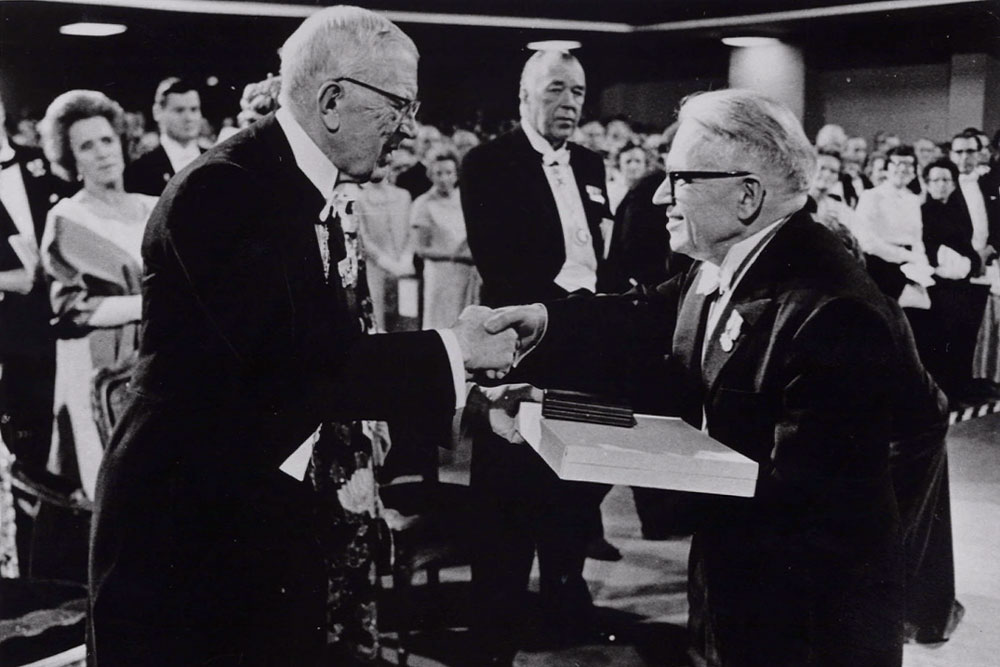Campus spaces named in honour of Nobel laureate
As part of a national initiative to mark the 50th anniversary of Dr. Gerhard Herzberg’s Nobel Prize, the University of Saskatchewan (USask) has named the main experimental hall of the Canadian Light Source (CLS) and a prominent physics lecture theatre on campus after the renowned scientist.
Refugees from Nazi persecution in 1935, Herzberg and his wife and fellow scientist Luise spent 10 productive years at USask. Three of Herzberg’s books were published during that time and are still considered classic works on atomic and molecular structure, advancing knowledge in chemistry, physics and astronomy.
Herzberg went on to receive the 1971 Nobel Prize in Chemistry.
In 2021, USask joined Defining Moments Canada, the National Research Council, Canadian Heritage and other partners on Herzberg50, a major digital project celebrating Herzberg’s life and achievements.
In November, the CLS announced that its main experimental hall—which houses Canada’s only synchrotron—would be renamed the Herzberg Experimental Hall. Additionally, the Department of Physics and Engineering Physics renamed the Physics 107 Lecture Theatre the Dr. Gerhard Herzberg Lecture Theatre.
“Canada and the University of Saskatchewan welcomed Herzberg and his wife when no other country or university did,” said USask President Dr. Peter Stoicheff. “His legacy is evident today in so many ways, including at our Canadian Light Source where scientists from across Canada and around the world continue to unravel the mysteries of atomic structure.”
‘They deserve to know’: Searching for lost graves of residential school children
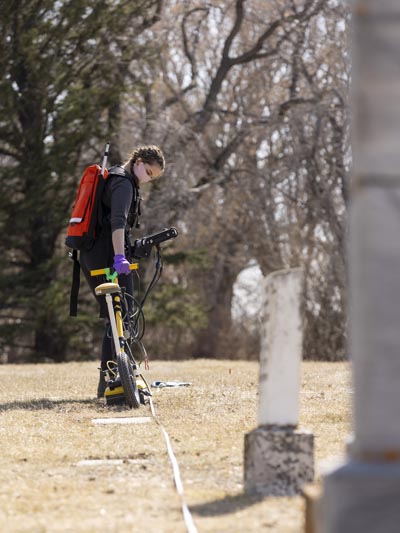
College of Arts and Science researchers are part of the ongoing search for unmarked graves of children at former Canadian residential schools.
A team led by Department of Archaeology and Anthropology faculty member Dr. Terence Clark has been working with several communities, including Muskowekwan First Nation in Saskatchewan, to locate burial sites of Indigenous children who died while forced to attend residential schools.
“This work is an important part of reconciliation. We must understand and acknowledge the harm done to Indigenous communities. The families and communities of these (children) still grieve for their loss; they deserve to know where their children are buried. It is an important step in the healing process, but certainly not the end of it,” said Clark.
The researchers use technologies such as ground-penetrating radar to scan beneath the surface without disturbing the soil.
“I think it is important, especially in the case of human remains, that they are treated with respect and dignity. By using these non-invasive procedures, we can provide closure and give communities the knowledge so they can make informed decisions about leaving the graves or reinterring them in other locations,” said Micaela Champagne, an archaeology master’s student involved with the search.
The work of Clark’s team at Muskowekwan First Nation has been featured in national and international media, including a New York Times video in October 2021 and a February 2022 episode of 60 Minutes.
College enters knowledge partnership with Mistawasis Nêhiyawak

The community of Mistawasis Nêhiyawak and the University of Saskatchewan (USask) College of Arts and Science have begun a new partnership dedicated to sharing and creating knowledge.
Leaders of the college and the community signed an Asota at a ceremony at Mistawasis Nêhiyawak—a First Nation located 120 km north of Saskatoon—in October 2021. Asota is a sacred Cree term that translates to “Make a Promise.”
Over the next five years, the community and the College of Arts and Science will develop new teaching and research collaborations in the areas of Indigenous wellbeing, community development and environmental stewardship.
“With this partnership, the College of Arts and Science is committing to a long-term relationship with Mistawasis Nêhiyawak built on cooperation and mutual learning. We hope to serve the needs of Mistawasis Nêhiyawak while respectfully bringing the community’s knowledge into our classrooms and research,” said Dr. Peta Bonham-Smith, dean of the College of Arts and Science.
One of the first outcomes of the partnership will be a class created jointly by Mistawasis Nêhiyawak High School and the college’s Department of Geography and Planning. In the course, USask undergraduate students will team up with high school students from Mistawasis to study environmental and health challenges facing the community, such as food and water security.
Warped crystals could open new era for quantum computing
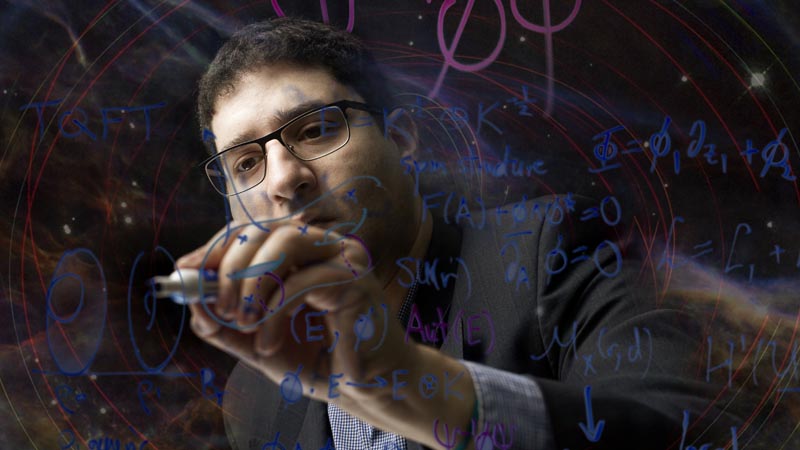
A recent paper co-authored by University of Saskatchewan (USask) mathematician Dr. Steven Rayan proposes a new theory that could lead to the next generation of quantum materials—the revolutionary materials that make technologies such as quantum computing possible.
Rayan and University of Alberta physicist Dr. Joseph Maciejko published their paper, titled “Hyperbolic band theory,” in the prestigious journal Science Advances in September 2021.
Their work points to the possibility of developing a larger class of quantum materials than previously known, opening the door to developing components for wider technological applications and advancements.
“Our paper is really a challenge to the science community: can we physically engineer and bring to life this new class of hyperbolic quantum material, and can we apply them in creative ways to emerging technologies such as quantum computers?” said Rayan, a faculty member in the Department of Mathematics and Statistics and the director of USask's Centre for Quantum Topology and its Applications.
Interest is high in developing quantum computers because not only are they far faster than current supercomputers, but they can quickly analyze problems with thousands of possible scenarios and provide the best solution.
Rayan said this capability is particularly valuable in designing vaccines and drugs, and in other applications such as developing smaller, less expensive and more accurate MRI technologies for use in remote areas or in harsh environments.
Science outreach program uses Cree syllabics to teach cryptography
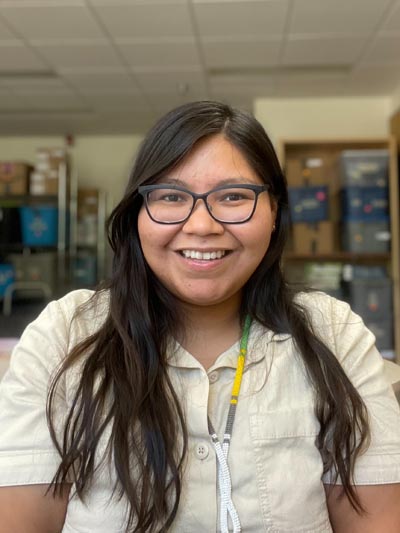
In fall 2021, science outreach instructors from the University of Saskatchewan (USask) connected codebreaking and Cree language for kids in Saskatoon.
A new lesson titled “Break the Code” was part of the year’s Kamskénow program offered by the College of Arts and Science. It used Cree syllabics—the set of symbols used to write Cree dialects—as a medium for teaching cryptography to Saskatoon schoolchildren.
Cree Autumn Sunrise Longjohn, the College of Arts and Science’s science outreach coordinator, designed the session, which teaches students to encode and decode words using a special map of Cree syllabics.
“I find it’s important to me, as an Indigenous student and as a person who is reclaiming their language, that my language be represented in something that I’m learning,” Longjohn said. “A lot of the students are probably in the same boat as me, where they’re still reclaiming their culture and their language. And so having all of this in a session where they can actually learn what each of the symbols mean and the origin of syllabics, I feel like it’s really important.”
Kamskénow is a science outreach program that offers hands-on science and mathematics activities to Saskatoon community school classrooms with a high population of Indigenous students.
Art project celebrating Indigenous knowledge reaches final step
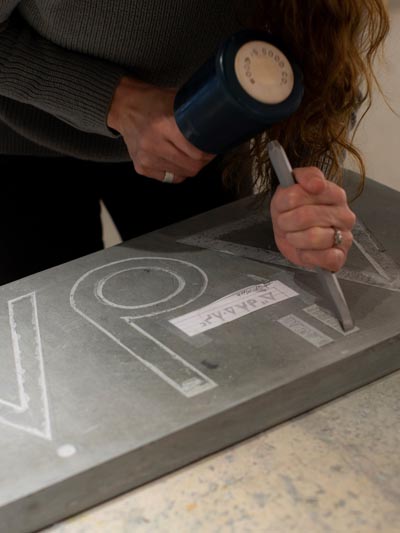
In September 2021, the last of 13 carved slate steps was installed at the Gordon Snelgrove Gallery in a collaborative art project more than a year in the making.
The project, anohc kipasikônaw/we rise/niipawi, was conceived in the College of Arts and Science in early 2020 as a way to celebrate Indigenous knowledge systems. To highlight the 13 moons of the lunar cycle, 13 carved stone steps would be installed on the USask campus over a period of months.
The steps, reclaimed from a staircase in the Thorvaldson Building on campus, were hand-carved with Cree syllabics representing the traditional names of the 13 moons.
Saskatchewan stone carver Lyndon Tootoosis, who was artist-in-residence with the USask Art Galleries and Collection in 2020, played a key role in launching the project along with artists and College of Arts and Science staff members Vanessa Hyggen (BA’17) and Dr. Sandy Bonny.
USask students, faculty and staff were invited to participate in carving the steps during Indigenous Achievement Week in February 2020.
The project continued even as the COVID-19 pandemic closed USask buildings. Relationships were built and strengthened with Elders, colleagues, students, artists and community members.
“When the discussions first began for the project, none of us thought that it was going to be such a long process. But it’s really been with us throughout our entire experience of this pandemic; it’s kept us connected in that way,” said Hyggen.
Highlighting Métis history in Saskatoon
A University of Saskatchewan (USask) researcher is using a technique known as deep mapping to shed new light on urban Métis experiences in 20th-century Saskatoon.
Dr. Cheryl Troupe (BA’01, MA’10, PhD’19), a faculty member in the Department of History, began the research project in collaboration with Métis Elders in Saskatoon and Gabriel Dumont Local #11.
Gabriel Dumont Local #11 is part of the Métis Nation-Saskatchewan (MN-S), a government that represents Métis people in the province. Troupe, a member of the MN-S and Local #11, wanted to work with members of her community to create a resource for the community.
Deep-mapping techniques highlight the connections between geographical places and people’s memories and personal identities. The process involves combining artifacts, photos, stories and other types of material culture into a map.
“I will interview Métis people at different places in the city that they determine are important to them, and we’ll talk about the stories that are connected to those places,” Troupe said.
Troupe will combine the stories and other data into maps, “so that their stories can be represented in a spatial way that demonstrates how Métis have used and occupied the city since the city’s founding,” she said. “Really, it’s about creating maps for the community to have access.”
Digital canoe replica on view at Remai Modern
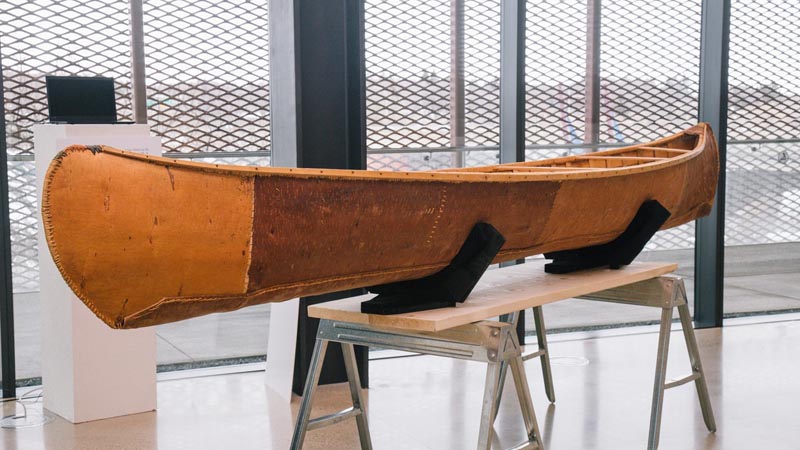
An augmented reality version of a traditional birch bark canoe produced through an interdisciplinary research initiative at the University of Saskatchewan (USask) is being showcased in a new art exhibition at Saskatoon’s Remai Modern.
The original canoe was built in the 1970s on the banks of Otter Lake, Sask., by Isaiah and Annie Roberts of the Lac La Ronge Indian Band. The process was documented in a film titled My Last Canoe that was produced by USask and the Federation of Sovereign Indigenous Nations.
For years following the filming of the video, the canoe was stored in the Archaeology Building on the USask campus until faculty members initiated its return to the Lac La Ronge community in 2020.
Before its repatriation, 3D documentation of the canoe was undertaken by Shared Spaces—a project of the USask Art Galleries and Collection that explores applications of augmented reality to the arts. As a result, visitors to Remai Modern can view a 3D model of the canoe through their smartphones.
Dr. Rose Roberts (BSN’96, MSc’01, PhD’06), granddaughter of Isaiah and Annie Roberts, is pleased that viewers will be able to see a recreation of her grandfather’s canoe. “It’s a really good feeling because it is such a gift, and he was so good at it,” Roberts said.
The digital canoe is part of an exhibition titled Canoe at Remai Modern. It runs until May 8.
Disrupting COVID-19 with potential new treatments: USask research
A University of Saskatchewan (USask) research team has discovered insights into the structure of the virus that causes COVID-19, possibly leading to new treatment options.
The virus that causes COVID-19, known as SARS-CoV-2, attaches to cells in the human body via spike proteins. These spikes allow the virus to infect cells, following which the virus replicates itself and spreads throughout the body. The spikes contain molecular structures called disulfides—pairs of sulphur atoms bound together—that may be important for holding the spikes in the correct shape for cell infection to occur.
With this knowledge, the research team investigated an important question about the SARS-CoV-2 virus: If the spike disulfides are disrupted, would this allow the virus to lose its ability to cause infection?
This question was answered through research conducted by two USask research associates, Dr. Andrey Grishin, from the College of Medicine, and Dr. Nataliya Dolgova, from the College of Arts and Science. The idea was first tested in computer models, with collaboration from Dr. Olivier Fissette at USask Advanced Research Computing, and then verified in live virus tests by Dr. Darryl Falzarano and Shelby Landreth at the Vaccine and Infectious Disease Organization.
The overall team involved a collaboration between three Tier 1 Canada Research Chairs—College of Medicine professor Dr. Miroslaw Cygler and College of Arts and Science professors Dr. Ingrid Pickering and Dr. Graham George (DSc’19).
“One of the many disulfides in the spikes seems to be very important in holding the spikes together, and breaking the disulfides disrupts viral infectivity,” said George. “It might be the basis of a new treatment, and should work for any future virus variants.”
George notes that—with only the current research to go on—any treatment agents developed would have to be given in high doses, but this finding could lead to further work that aims to disrupt these important viral structures, and thus render the virus less infectious.
Evolutionary biology brings new life to medieval literature

Italian poet Dante Alighieri’s epic poem Divine Comedy (Commedia) is now available for free and in richer detail than ever before, thanks to an online platform created with University of Saskatchewan (USask) research.
As part of festivities in 2021 commemorating the 700th anniversary of Dante’s death, an international team of researchers including USask English professor Dr. Peter Robinson launched a new online edition of the Italian masterwork with a twist—using evolutionary biology to trace how previous versions are related.
“This edition brings phylogenetic and database tools together with traditional scholarly research in a way never before available,” said Robinson.
The culmination of years of negotiations, the free online resource located at www.dantecommedia.it makes widely accessible what was “previously available only to a very few readers with privileged access to the great libraries of Europe,” said Robinson.
This new edition breaks ground in many ways; it is the first edition of any major work by any author in any language to bring together, in a free online interface, full sets of images of seven key manuscripts and two modern editions—more than 2000 pages.
The mobile phone-friendly platform includes specialized tools for exploring the relationships between the texts, and a word-by-word comparison of all the texts, including all variants of every word.
Donors support creation of new prize for Indigenous artists
The University of Saskatchewan (USask) has launched ohpinamake, a new prize for Indigenous artists, made possible thanks to the generous support of donors Jim and Marian Knock.
The donors, originally from Saskatchewan and now residing in Victoria, B.C., have provided $50,000 for ohpinamake, which will be administered by the USask Art Galleries and Collection. An award of $10,000 will be provided annually for the next five years to Indigenous artists whose territories intersect with the current colonial borders of Canada.
“The creation of the ohpinamake award is a step toward reconciling centuries of Indigenous artists having gone unnoticed within Western culture,” said Dr. Angela Jaime, USask interim vice-provost, Indigenous engagement. “This recognition is for artists challenging our perception of difference and creating new space for thinking outside the box.”
The word ohpinamake is a nêhiyawêwin (Cree) term meaning “to lift others.” The name was gifted to the USask Art Galleries and Collection by a group of three Indigenous community leaders: Elders Maria Campbell and Louise Bernice Halfe – Sky Dancer, and artist and USask alumna Ruth Cuthand (BFA’83, MFA’92).
Jim and Marian Knock sought to partner with USask to create an award that positions art to bridge differences. They see Indigenous art, along with sensorial engagement between all Canadians, as the way to communicate most fully the knowledge needed to move forward together in the spirit of reconciliation.
USask launches symphony orchestra
The University of Saskatchewan (USask) has launched a new symphony orchestra that features musicians from on and off campus.
Renowned conductor Shah Sadikov, a sessional lecturer in the Department of Music, directs the new USask Symphony Orchestra. The ensemble is open to students, staff members and community musicians who play violin, viola, cello and/or double bass.
The new ensemble was created to provide an opportunity for people to enjoy making music together in a relaxed environment.
“It hits all the important notes that the department deems important for its mission: giving a quality experience for the students, a department being an inclusive place for everyone at the university and, very importantly, being an ambassador of community outreach,” said Sadikov, who has previously conducted ensembles including the National Symphony Orchestra of Uzbekistan, the Tokyo Philharmonic and the Berlin Sinfonietta.
Launched in September 2021, the USask Symphony Orchestra held its debut concert on campus in early December.
Drama bursary named for Henry Woolf
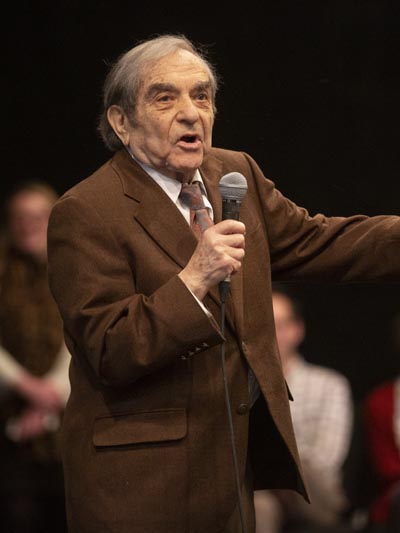
The University of Saskatchewan (USask) Department of Drama has launched a new award in honour of one of Saskatoon’s most beloved theatre professionals.
The Henry Woolf Bursary is a $1,000 award named for Prof. Emeritus Henry Woolf, who passed away in November 2021. Woolf was a retired faculty member and former head of the Department of Drama who had been influential locally and internationally as an actor, teacher, director and playwright.
Woolf lived to see the inaugural award be given to student actor Christopher Krug-Iron (BEd’21) in June 2021.
“I just am delighted that this particular young man, whom I’ve watched onstage several times, has been selected. And I really wish him well, because he deserves to do well,” Woolf said at the time.
Funded by community donors, the Henry Woolf Bursary in Drama was created by the department to provide financial assistance to undergraduate students majoring in drama. The award was first announced at a naming event for the Henry Woolf Theatre in USask’s John Mitchell Building, which took place on Woolf’s 90th birthday in June 2020.
In a speech at that event, Woolf spoke about the importance of the arts.
“The arts are what stimulate the imagination. And without the imagination, we lead a deprived life. Living without art in one’s life is like living in a house without windows,” he said.
New scholarships funded through gift

Students at the University of Saskatchewan (USask) will soon have access to additional scholarships to support their educational journeys, thanks to a $100,000 gift to the College of Arts and Science.
The new Gerald & Joan Johnson Endowed Student Award will support undergraduate students in the college who are studying in fine arts, environmental studies or astronomy programs, with a preference for students from southwest Saskatchewan and/or former employees of Cypress Hills Provincial Park.
“On behalf of the College of Arts and Science, I would like to express our gratitude for this generous gift to fund the Gerald & Joan Johnson Endowed Student Award,” said Dr. Peta Bonham-Smith, dean of the College of Arts and Science.
“Our college is proud to be the home of the fine arts and astronomy on the University of Saskatchewan campus, and we also offer several interdisciplinary environmental programs that address some of the most important issues of our time. These excellent degree pathways will be strengthened by this new award, which will provide support to our talented and dedicated students as they continue to work toward their academic goals and be what the world needs.”
The scholarship fund was established by the Friends of Cypress Hills Park, a not-for-profit organization that works collaboratively with Saskatchewan’s Cypress Hills Provincial Park to enhance educational, recreational and interpretive programs in the area and to assist in the maintenance and securing of facilities in the park. The gift was made possible thanks to the generosity of Gerald and Joan Johnson, long-time residents of Cypress Hills Park.
The Johnsons, who had lived in a cottage in the area on a full-time basis since the 1980s, approached the Friends of Cypress Hills Park around 2003 to see if the group would be interested in taking their home to repurpose as a retreat space. After the Friends acquired the cottage, it served as an artists’ retreat for several years, from about 2015 until 2020. The Friends later decided to sell the cottage and establish the Gerald & Joan Johnson Endowed Student Award with some of the proceeds of the sale.
“I kind of feel that the Friends are just a go-between here—it really is money that came from Gerald and Joan Johnson,” said Gerald Gartner, CEO of the Friends of Cypress Hills Park.
The Gerald & Joan Johnson Endowed Student Award will be open to continuing undergraduate students pursuing degrees in the fine arts or astronomy (including a minor), as well as environmental studies programs offered in the College of Arts and Science, such as environment and society, environmental biology and environmental geoscience.
